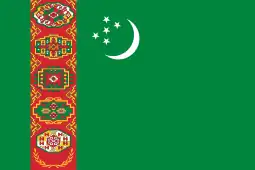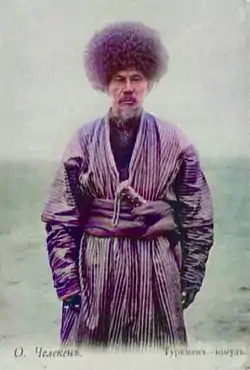| Part of a series on the |
| Culture of Turkmenistan |
|---|
 |
| History |
| Cuisine |
| Festivals |
| Religion |
| Literature |
| Music |

The Turkmen people have traditionally been nomads and equestrians, and even today after the fall of the USSR attempts to urbanize the Turkmens have not been very successful. They never really formed a coherent nation or ethnic group until they were forged into one by Joseph Stalin in the 1930s. Rather they are divided into clans, and each clan has its own dialect and style of dress. Turkmens are famous for making knotted Turkmen carpets, often mistakenly called "Bukhara rugs" in the West. These are elaborate and colorful hand-knotted carpets, and these too help indicate the distinctions among the various Turkmen clans.
The Turkmens are Sunni Muslims but they, like most of the region's nomads, adhere to Islam.
A Turkmen man can be identified anywhere by the traditional "telpek" hats, which are large black or white sheepskin hats that resemble afros. Traditional dress for men consists of high, shaggy sheepskin hats and red robes over white shirts. Women wear long sack-dresses over narrow trousers (the pants are trimmed with a band of embroidery at the ankle). Female headdresses usually consist of silver jewelry. Bracelets and brooches are set with semi-precious stones.
History
Language
Outside the capital, the national language of Turkmen is the most widely encountered. In Ashgabat and Türkmenbaşy, the Russian language is commonly encountered; however, with recent efforts to revive the ancient culture of Turkmenistan, Turkmen is quickly regaining its place as the chief language of the state.
Literature
Two significant figures in traditional Turkmen literature are the poets Magtymguly Pyragy and Mämmetweli Kemine.
Theatre
There are 10 state theaters in Turkmenistan: 5 in Ashgabat and 5 in regional centers. [1]
Music
Turkmen music is very similar to Khorasani music.
Heritage sites
| Image | Name | Location | Notes | Date added | Type |
|---|---|---|---|---|---|
 |
Ancient Merv | Baýramaly, Mary Region | a major oasis-city in Central Asia, on the historical Silk Road | 1995 | Cultural[2] |
 |
Köneürgenç | Köneürgenç | unexcavated ruins of the 12th-century capital of Khwarazm | 2005 | Cultural[3] |
 |
Parthian Fortresses of Nisa | Bagyr neighborhood, Ashgabat | one of the first capitals of the Parthians | 2007 | Cultural[4] |
Gallery
 Tekke Turkmen kapunuk (door surround), early 19th century. A kapunuk is designed to surround a door frame, providing a decorative entry to a circular Turkmen yurt.
Tekke Turkmen kapunuk (door surround), early 19th century. A kapunuk is designed to surround a door frame, providing a decorative entry to a circular Turkmen yurt.

 Turkmen man and his son hoist the flag of Turkmenistan while on horseback at the opening ceremony for the 2008 World Nomad Games.
Turkmen man and his son hoist the flag of Turkmenistan while on horseback at the opening ceremony for the 2008 World Nomad Games.
See also
References
- ↑ В Туркменистане утверждён порядок предоставления театрам статусов «Академический» и «Национальный»
- ↑ UNESCO World Heritage Centre (26 January 2009). "Ancient Merv State Historical and Cultural Park". Whc.unesco.org. Retrieved 25 November 2013.
- ↑ UNESCO World Heritage Centre (15 July 2005). "Köneürgenç". Whc.unesco.org. Retrieved 25 November 2013.
- ↑ UNESCO World Heritage Centre. "Nisa Fortress". Whc.unesco.org. Retrieved 25 November 2013.
Further reading
- Blackwell, Carole (2001). Tradition and Society in Turkmenistan: Gender, Oral Culture and Song. Curzon. ISBN 0-7007-1354-9.
- Clement, Victoria (2018). Learning to Become Turkmen. University of Pittsburgh Press. ISBN 978-0822964636.
- Edgar, Adrienne Lynn (2004). Tribal Nation: The Making of Soviet Turkmenistan. Princeton University Press. ISBN 978-0-691-12799-6.
- Smith, Graham, ed. (1995). The Nationalities Question in the Soviet Union (2nd ed.).
External links